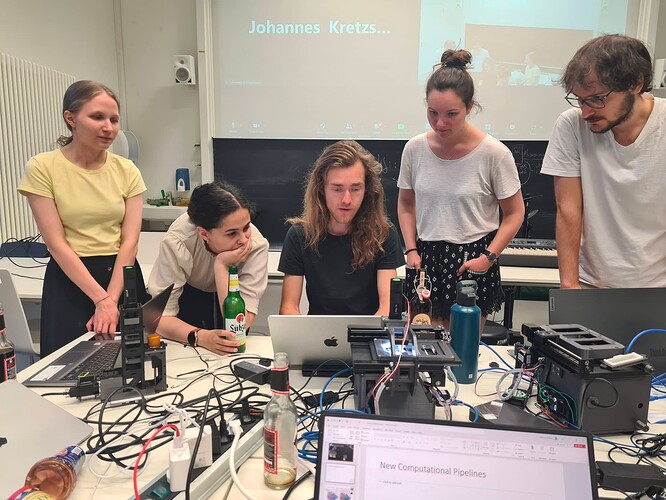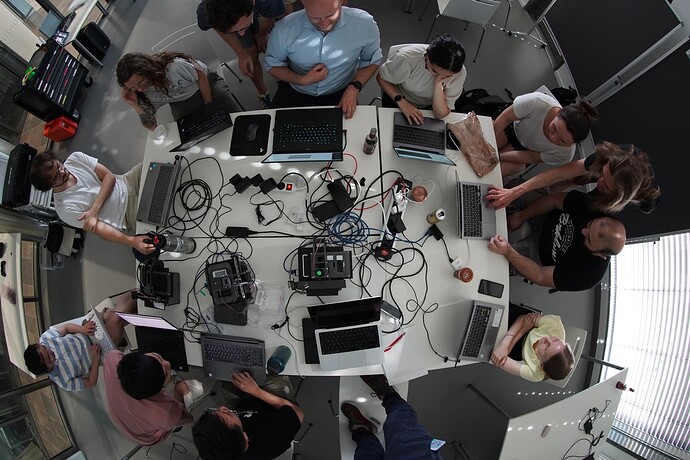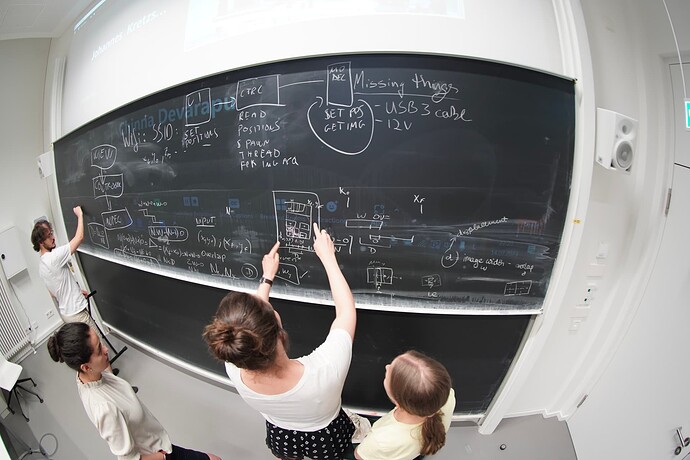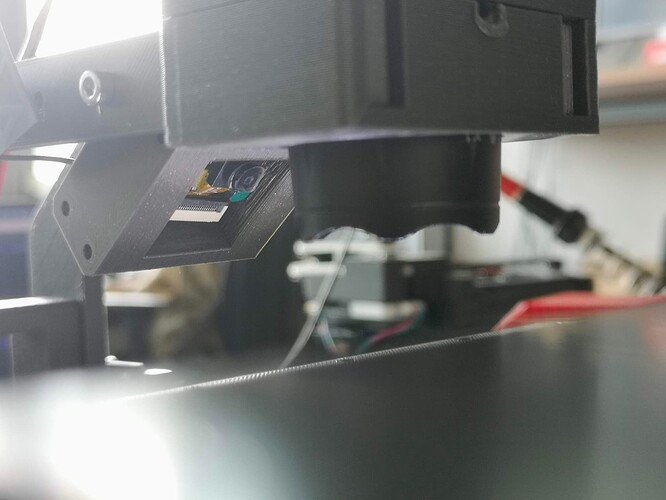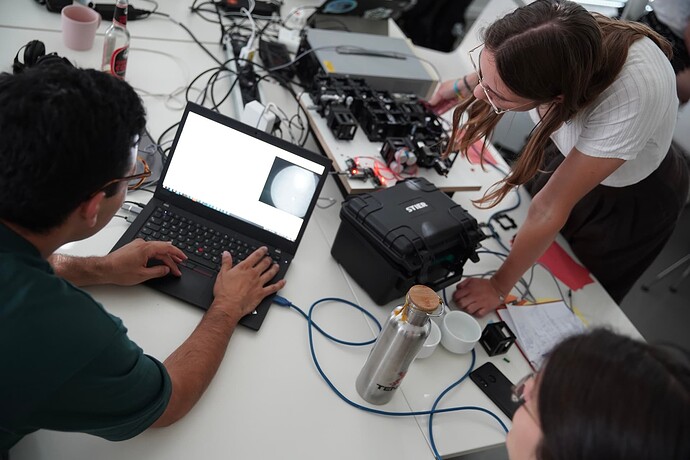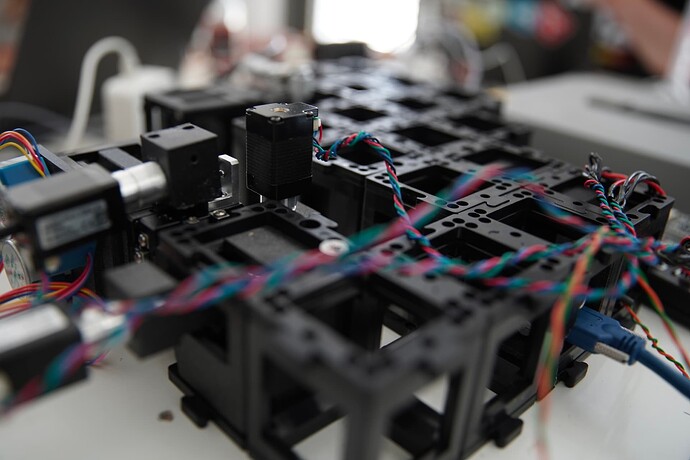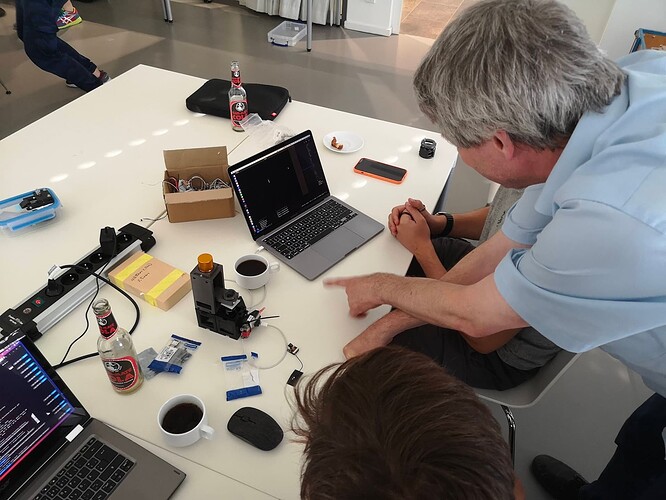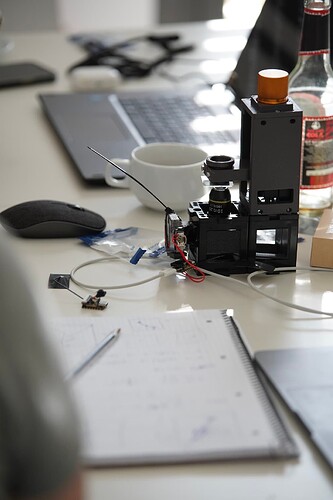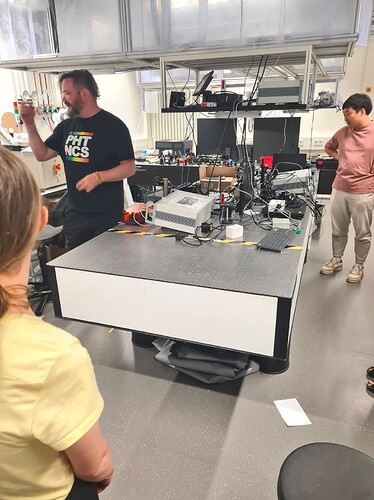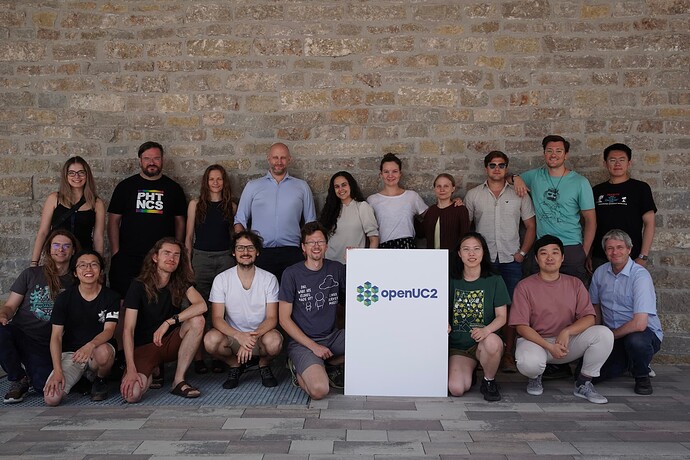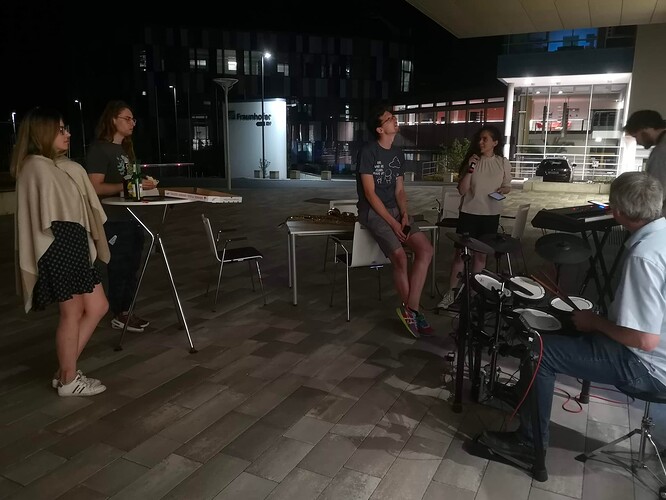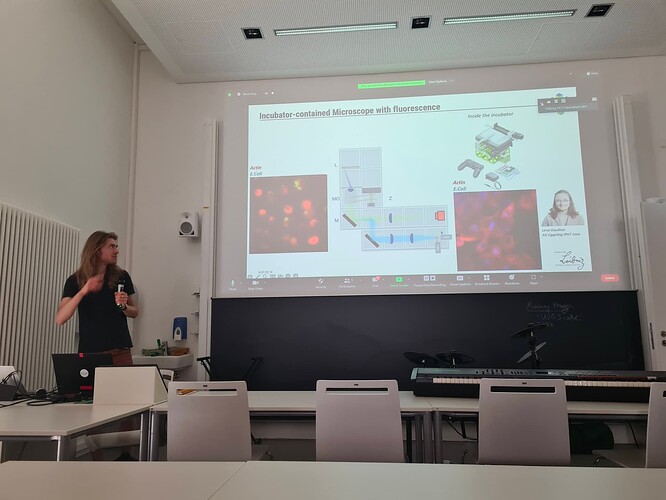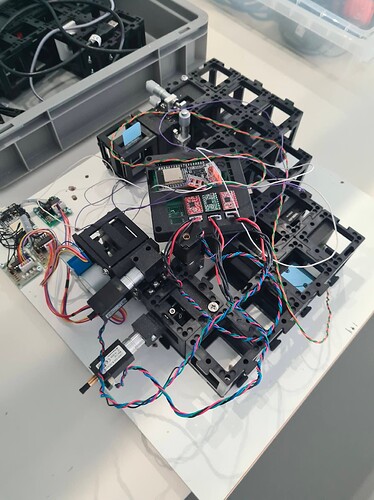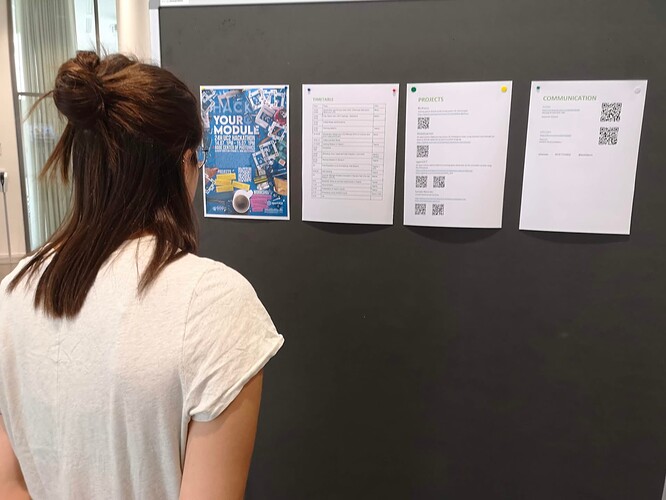Final Report: openUC2 Hackathon – Design your Module
We are pleased to report the resounding success of the openUC2 Hackathon, a collaborative event aimed at advancing open-source optics. The 24-hour hackathon brought together participants from Finland, the Netherlands, and Germany, creating a diverse and innovative atmosphere.
Projects and Achievements:
- Histoscanner: Developed an open-source slide scanning system using ImSwitch and ASHLAR, revolutionizing plant-oriented imaging.
- openOCT: Created an affordable OCT system with remote control capabilities, advancing full-field incoherent interferometry.
- BluFocus Autofocus: Collaborated with BluFocus to develop a cost-effective and precise autofocus system for microscopy using the optical pickup unit (OPU) from a PS3 Blu-ray drive.
Hackathon Agenda
The hackathon’s agenda was carefully designed to ensure a productive and engaging environment for all participants. It commenced with an introduction session led by Benedict Diederich, where participants were acquainted with the challenge description and had the opportunity to showcase their UC2 modules and experiences with the system. A notable keynote speaker, Edwin Hwu, joined remotely to share insights on hacking and repurposing parts for scientific applications, inspiring the participants with his expertise.
Selected Projects
The selection of hackathon topics was driven by the openUC2 community, who suggested ideas to enhance the UC2 ecosystem. After a two-week period of collecting suggestions through a Google Form, we conducted a Twitter-based survey to determine the most desired modules. The community’s input led us to choose the following projects:
-
Histoscanner: a remote-controlled OCT system
-
Autofocus system based on the PlayStation 3 OPU and the SEEED XIAO Sense camera
-
Optional project: cassette sample recorder
We were fortunate to have more open spots than applicants, allowing us to accept every participant who expressed interest.
Collaboration and Diversity
The diversity of backgrounds among the participants, including biology, computational science, physics, engineering, and medicine, greatly contributed to the success of the hackathon. The synergy among the team members was exceptional, with 50% of the participants working without sleep, showcasing their high motivation and dedication to the projects. The collaborative and interdisciplinary nature of the event proved to be a winning formula, resulting in remarkable outcomes and inspiring new ideas for future endeavors. Almost 50% of the participants were female.
Projects and Repositories
The hackathon focused on four community-selected challenges, each of which was thoroughly documented prior to the event to allow online participants to contribute remotely. The projects and their corresponding repositories are as follows:
-
BluFocus - A bluray player-based autofocusing system for microscopes. The project repository can be found here.
-
HistoScanner - An open-source slide scanning system for histological slides using ImSwitch and ASHLAR. The project repository is available here.
-
openOCT - An open-source optical coherence tomography setup that can be controlled remotely using the TwinLab. The project repository can be accessed here.
-
CassetteSampler (Optional) - This project involved cassette-based sample handling using the ESPressoscopes. The project repository can be explored here, while information about the ESPressoscopes is available here.
Support and Accessibility
We are grateful for the support of the GOSH community and funding by the Sloan foundation, whose collaboration and dedication were instrumental in making this extraordinary event a reality. The hackathon showcased the power of open innovation, fostering new ideas and significantly improving user and community interaction.
The entire event was live-streamed, enabling approximately ten online participants to be part of the experience from the beginning. All project results, documentation, and discussions were openly accessible through GitHub repositories and a dedicated Discord channel, ensuring transparency and facilitating further collaboration.
Project Highlights
In the subsequent sections of this report, we will provide detailed information on each project and present the outstanding results achieved by the participating teams. The openUC2 Hackathon has proven to be a resounding success, demonstrating the immense potential of open-source collaboration and inspiring future initiatives in the field of optics.
Histoscanner Project
The Histoscanner project was a significant focus of the hackathon, with the objective of developing an open-source solution for high-resolution histology imaging. The project aimed to create an efficient and automated system for scanning large areas and saving the data in an open file format with all necessary metadata for subsequent processing.
To achieve this goal, the project team utilized the openUC2 XYZ stage scanning microscope, which provided a solid foundation for the development of the Histoscanner. The software ImSwitch played a crucial role in the project, as the team developed a plugin that seamlessly integrated with ImSwitch, enabling automated scanning of large areas. The resulting data was saved in an open file format, ensuring compatibility with various software applications for further processing.
Throughout the hackathon, the team encountered challenges in integrating ASHLAR, a stitching software, into ImSwitch. Additionally, they worked closely with the openflexure community, collaborating on a similar stitching algorithm. Through troubleshooting and continuous efforts, the team successfully integrated ASHLAR into ImSwitch, achieving a functional system by the late hours of the hackathon.
The end result of the Histoscanner project was a large stitch of multiple gigabytes, capable of being processed with software such as Qpath. This achievement marked a significant milestone, as it represented the first entirely open-source system capable of fast and large area image scanning in the field of histology.
The Histoscanner project exemplifies the power of collaboration and open-source innovation, showcasing the potential for creating accessible and advanced imaging systems for histological analysis.
OpenOCT Project
The openOCT project aimed to develop an affordable and accessible optical coherence tomography (OCT) system based on a full-field incoherent interferometer setup. The project had several key objectives to achieve during the hackathon.
Participants initially familiarized themselves with the OCT system, gaining an understanding of its components and operation. They successfully observed fringes generated by the low-coherence illumination source, indicating the presence of interference. However, stabilizing the imaging process proved challenging due to room vibrations and stray light, which caused delays in the analysis.
To enhance automation capabilities, the team integrated low-cost stepper motors into the system, enabling precise movement of the reference mirror. This automation was achieved using the UC2-REST system, which facilitated communication between the Jupyter notebook and the external ESP32-driven hardware. By moving the reference mirror along the optical axis, an image stack or interferogram was obtained, with the contrast being tracked over the z-axis.
The reconstruction of the acquired OCT data revealed clear images of the mirror surface, demonstrating the successful operation of the openOCT system. Moving forward, the team envisioned significant improvements in reducing the overall size of the setup, making it more compact and portable.
The openOCT project showcased the potential for developing an accessible OCT system using open-source hardware and software. By addressing the challenges associated with system stability and automation, the project made significant strides towards realizing an affordable OCT solution for various applications.
The openOCT project’s success during the hackathon highlighted the importance of collaborative efforts and open innovation in creating novel scientific tools that can benefit researchers and practitioners worldwide.
BluFocus Autofocus Project
UC2 Hackathon undertook an exciting project to explore hardware-based autofocus for microscopy. The project focused on utilizing the optical pickup unit (OPU) from a PS3 Blu-ray drive to develop an affordable and precise autofocus system. The BluFocus autofocus project had specific objectives to achieve during the hackathon.
Participants began by establishing a stable communication interface between the SEEED XIAO ESP32-S3 camera and Python. This allowed for the transfer of raw images, which were essential for detecting the astigmatism-based autofocus signal. Multiple focus tracking algorithms were tested, with the team ultimately implementing a variation-based algorithm that demonstrated robustness against noise and illumination inhomogeneities.
The project team successfully integrated the SEEED XIAO ESP32-S3 camera with the modified OPU, enabling image acquisition and processing. They developed a feedback loop system that automatically adjusted the z-stage to maintain focus on the sample during microscopy experiments. The resulting autofocus system offered a cost-effective solution with professional-grade performance, making it highly accessible for microscope users.
The BluFocus autofocus project directly benefited from the introductory talk by Edwin Hwu, which provided valuable insights into OPU hacking and repurposing for scientific applications. The project’s success in developing an affordable and efficient autofocus system demonstrated the power of open innovation and community collaboration.
By leveraging the expertise of the participants and the resources available within the openUC2 community, the BluFocus autofocus project achieved its objectives and delivered a significant contribution to the field of microscopy. The developed autofocus system holds great potential for enhancing microscopy workflows and enabling researchers to achieve precise focus in their experiments.
Closing Remarks
The openUC2 Hackathon was an overwhelming success, thanks to the participation and collaboration of passionate individuals from diverse backgrounds. Throughout the event, participants demonstrated exceptional creativity, technical skills, and teamwork. The hackathon fostered an environment of knowledge-sharing, innovation, and community building. It provided an excellent platform for participants to learn, contribute, and make meaningful advancements in optics using the UC2 platform.
Outside the problem-oriented hacking, participants enjoyed the entire program that included a Jam Session past midnight, an introduction into AR/VR-driven optics by Rainer Heintzmann, and great catering offered throughout the event.
We express our sincere gratitude to the GOSH Community and the Sloan foundation for providing the funding that made this hackathon possible. Your support enabled us to organize the event, provide necessary resources, and foster a vibrant community of innovators. The impact of your contribution extends beyond the hackathon itself, as the developed projects will continue to evolve and benefit the broader scientific community. We are looking forward to a continuation of this event.
Conclusion
In conclusion, the openUC2 Hackathon has made significant strides in advancing open-source rapid prototyping in optics. The accomplishments achieved during the hackathon would not have been possible without your generous support. We are confident that the openOCT system, BluFocus autofocus project, and the Histoscanner will contribute to the democratization of optical imaging technologies and promote accessibility in scientific research. We are continuing the collaborations from now on.
We extend our heartfelt appreciation to [Funding Agency] for their belief in our vision and for providing the necessary funding to realize this hackathon. We look forward to continued collaboration and the opportunity to showcase further advancements resulting from this successful event.
Thank you once again for your invaluable support.
We also want to thank @monica_seeed and Seeed Studio for supporting our project with the SEEED Xiao Sense camera kits and @EdwinHwu presenting an incredible collection of amazing hacks where off-the-shelf parts help to accelerate science.
